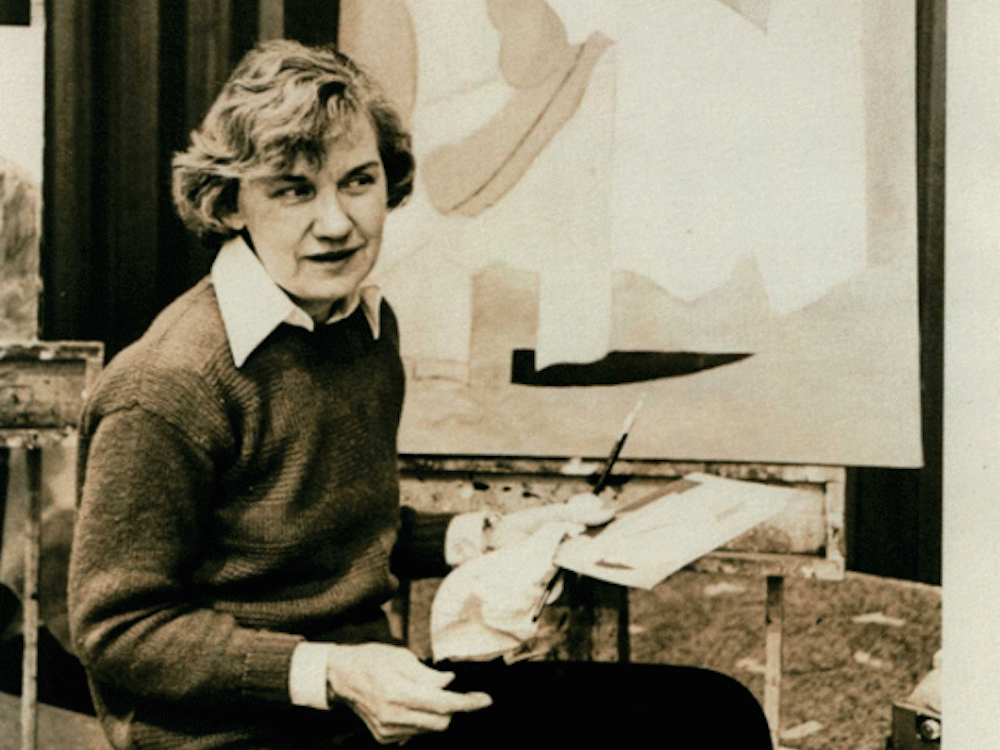In a paper gesture to the fistfuls of wilting dandelions offered by children, and beloved—surely!—by mothers all over the dandelion-growing world, I offer my mother Newcomb’s Wildflower Guide. I can remember Mom saying about certain plants, They grow where they are planted; in her tone, gratitude and admiration for the least fussy members of the garden. Were they wildflowers, which, as Dolly Parton sings, “don’t care where they grow”? Weren’t all flowers wild, at some point? Perhaps some are closer to their primal selves than others. At any rate, Mom—a Manhattanite transplanted to New England, with a few trying stops along the way—admires a plant that can make itself at home, and I’m grateful to her for encouraging, in conversation and by example, a weed-like adaptability in her children. In his guidebook, Lawrence Newcomb lets us get to know actual wildflowers with a neat key based on simple distinctions of flower shape, number of parts, and the shape and arrangement of leaves; detailed illustrations; and, important for my word-loving mother, a fine glossary of excellent botanical words: calyx, spadix, corymb; bulblet, axil, umbel. Today I identified a backyard flower as a celandine poppy: four symmetrical petals, deeply lobed leaves in opposite pairs. Newcomb describes this flower as “juice yellow.” He also notes its growing zone, which lies between western Pennsylvania and southern Wisconsin. Someone must have planted it in my scrubby little New York yard, where it now flourishes. I wish that I could keep a cutting from wilting and bring my mother a juice-yellow nosegay. —Jane Breakell
I haven’t read anything lately that reminds me specifically of my mother or even moms in general, so for Mother’s Day, I thought I’d ask my mom about the book she’s been reading: On Lighthouses, by Jazmina Barrera, translated from the Spanish by Christina MacSweeney. My mother has a healthy appetite for exploration, and it’s a shame that Mother’s Day this year will go by without some sort of adventure. When I moved to the city, I bought her the guidebook 111 Places in New York You Must Not Miss, which has taken us to locales as varied as the Merchant House Museum and the SeaGlass Carousel in Battery Park. On Lighthouses, based on what she tells me, is the history of six lighthouses in America. Some chapters start with a story; another chapter is the diary of a lighthouse keeper. Lighthouses, the “frontier between civilization and nature,” are places of solitude. But they are also signals of shore and home. This book is a light at the end of the tunnel, showing us places we’ll see and things we’ll do when we can go out again; my mom tends the lighthouse. —Lauren Kane
As my first Mother’s Day at home in years approaches, I’ve turned to Margaret Brown Kilik’s posthumous novel The Duchess of Angus, which tells the autobiographical story of Jane Davis, an English major who returns home to San Antonio to live in her mother’s run-down hotel. My own mother, with whom I am sheltering now, taught me to recognize good literature. Her lessons: Joan Didion’s Slouching towards Bethlehem, Marilynne Robinson’s Housekeeping, and, more recently, Toni Morrison’s Beloved. Kilik deserves a place in this canon, but her midcentury novel was only just published in March. Jenny Davidson—Kilik’s step-granddaughter and my professor at Columbia—prepared the manuscript for publication after acquiring it in 2017. Davidson’s introduction is as intelligent as the novel itself. She explores the history of Kilik’s eccentric mother, Agnes, also writing that the author’s voice contains “the flat affect and disturbing candor found in the fiction of J. D. Salinger and Sylvia Plath.” Kilik’s blunt sense of humor could even be compared to that of Dorothy Parker, though her protagonist is able to generate witty comebacks or aphorisms only after the moment has passed. In Jane’s own words: “I was furious. Senselessly furious. At that time I had not yet learned to bone up on the answers in anticipation of the questions. I lacked the presence of mind to retort, and it was useless to depend upon the depth of my emotions to see me through, for like domestic champagne, they never quite bubbled up to their potential but were more often lost in the yellow liquid. I groped about in my silent prison while the moment passed.” Jane vacillates between youthful euphoria and self-hatred. And her inarticulateness in real time draws a sharp contrast to the cruel judgments she makes of herself and others in thought. The Duchess of Agnes, a joint feat by Kilik and Davidson, is the perfect starter for book clubs among mothers and daughters who now find themselves living together again. —Elinor Hitt
Bernadine Evaristo’s Girl, Woman, Other was the first of my quarantine reads, but seven weeks and twelve books later, it is still the one I think of most, particularly as Mother’s Day approaches. Here is a multigenerational, multifocal narrative about strong women, motherhood, and networks of female friendship in the contemporary UK (though Evaristo admirably stretches those narratives back most of a century). I don’t need to speak of its merits—the book won the Booker; enough said—but it did inspire me to appreciate all the women in my life anew, their narratives, how our paths approach one another and split apart again, and how, with good luck, those paths sometimes intersect in ways that make each thread stronger. Right now those intersections are virtual—talking Chekhov with my mom as she shelters in Maine, sending my best friend a video message for her first Mother’s Day, reading Yum Yum Dim Sum to a friend’s kids in Queens (which will have to do until we can get together in Flushing again—I can taste the shumai). Nothing is as good as being able to show up on my mom’s doorstep and surprise the snot out of her—but for now, I’m grateful for literature that helps us appreciate mothers, and technology that lets us tell them so. —Emily Nemens
I hated nature, Mum, which looked better in photographs; Britain was sodden, as advertised, the countryside tasteless and passé in its browns and greens and grays, and everywhere the warbles and shrieks of birds pealed, telling nothing. I wanted it all gilded and wrought and Romantic. Still, not to be alone, I trudged along, preferring the sounds I gleaned from your patient taxonomy: whimbrel, kittiwake, chiffchaff, dunnock, nightjar. Eventually, among other things, I learned from you to tell a brambling from a chaffinch, and that no, the glint in the distance was not a goldfinch. I read R. F. Langley’s (1938–2011) poems with you because I could make no sense of them. I was astounded by their strange, off-kilter rhythms, their dense rhymes and unspooled syllables, and how lines shaped the mouth in recitation. Langley writes: “Talk to mother. Speak in a natural / easy voice, cruising the words. Cirrus and / thisles. Thiskin. Largesse. Debonair. Then / oaks and hornbeams and forever.” But as he speaks, the words break and meld: “Say that mother is out there, / and she is thiswise, thissen, thiskin, which / is thistles, cirrus cruising de bonne aire.” The meaning remained remote until you explained the terms—Callophrys, Grimmia—that granted access and denoted clearly what was there. The more we read, the more they unfurled; too often, what seemed to be a private obscurity just demanded attention. As he writes of a beetle: “Detail is so sharp / and so minute that the total form suggests / infinity.” Like you, Langley showed me how to see. His Complete Poems, comprising just forty-eight written over nearly four decades, is my most treasured book, even as it still eludes me. The last poem, his most transparent, “To a Nightingale,” begins from “Nothing”—there is a poet paused in the countryside, then birdsong. “I am / empty, stopped at nothing, as / I wait for this song to shoot.” Yet the poem slowly fills in the small particulars that shape the whole: “Red mites bowling / about on the baked lichen”; “Darkwing. The / flutter. Doubles and blurs the / margin”; a voice like “a soft cuckle of / wet pebbles.” You tell me about the visitors in isolation: the barn owl watching Poldark with you through the undrawn window, the jostling of squirrels who lost their nuts, and a local cat’s Jacobean slaughter of sparrows. With a leaf between the fingers, Langley writes: “There seems // to be no limit to / the amount of life it / would be good to have.” I long for the loam, for the puddle-furrowed paths to Grantchester, to see an arrow of geese above the fens, or to wait for a kingfisher, hushed in a hide with you. Sitting by my window, as I think of you, Mum, I sound the names of the birds that pass: pigeon, pigeon, pigeon, pigeon, pigeon. —Chris Littlewood
from The Paris Review https://ift.tt/2LbBs5l



Comments
Post a Comment